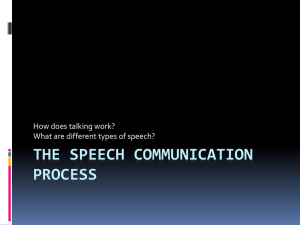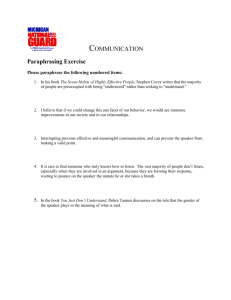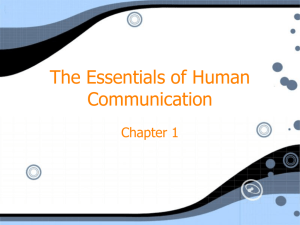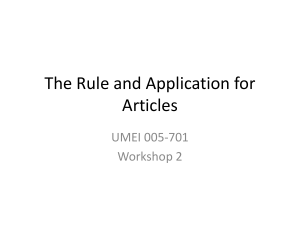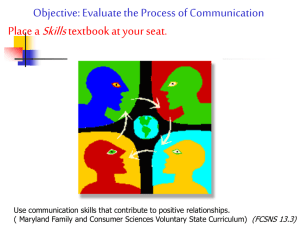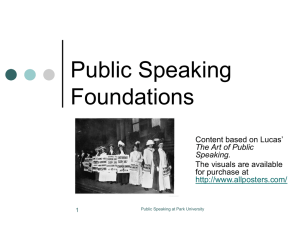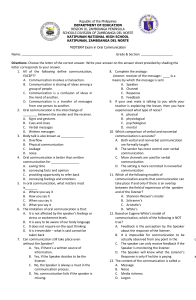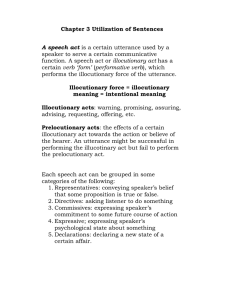The Essentials of Human Communication
advertisement
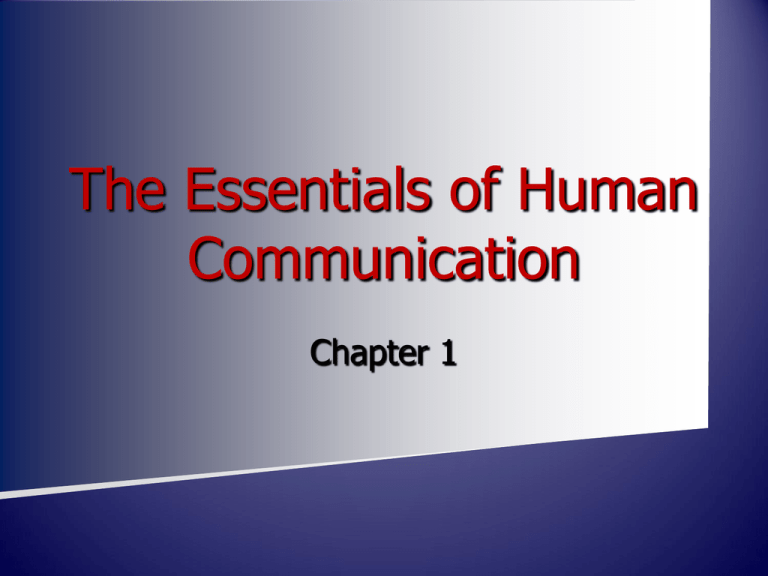
The Essentials of Human Communication Chapter 1 What is Communication? Human Communication consists of the sending and receiving of verbal and nonverbal messages between of two or more people Skills of Human Communication Skills of Human Communication Self Presentation- how you present yourself as confident, credible likeable and approachable Relationship Skills-how to initiate, maintain, repair and dissolve to be better friend, family member, coworker, girlfriend/boyfriend Interviewing Skills-job interviews Skills of Human Communication Cont. Group Interaction and Leadership Skillsparticipating as an effective group member in relationships and task groups Presentation Skills- Speaking to small and large audiences to inform or to persuade builds self confidence and serves a larger common good Media Literacy- Being a critical user of the varied mass media encountered on a daily basis helps one to act as an informed citizen and consumer Forms of Human Communication Intrapersonal CommunicationCommunication you have with yourself. It is how you discover who you are! Interpersonal-2 person communication Relationships that help you interact with others, learn about yourself and reveal yourself to others. InterviewingQuestion and Answer Communication Receiving counseling and conducting interviews. Small Group CommunicationCommunication Between 5-10 People Building relationships, developing new ideas, completing task etc. Public- Communication as a speaker to an Audience Inform and Persuade others Computer-mediated Communication-Communication through the computer – IM, E-mail, Facebook, Myspace, Chats, Blog etc. Possible Misconceptions in Human Communication The more you communicate the better your communication will be. When two people are in a close relationship, neither person should have to explicitly communicate needs and wants Interpersonal or group conflict is a reliable sign that the relationship or group is in trouble Possible Misconceptions in Human Communications Like good communicators, leaders are born, not made. Fear of public speaking is detrimental and must be eliminated The MODELS OF COMMUNICATION Linear Model Speaker Listener Linear Model- the speaker speaks and the listener listens Interactional Model Sender/Encoder Listener/Decoder the speaker and listener were seen as exchanging turns at speaking and listening Transactional Model Sender Noise Receiver Transactional Model- Each person is simultaneously the listener and speaker. Holds that the elements of communication are interdependent, a change in any element can produce a change in other elements Communication must be kept in Context The context to a large extent determines the meaning of any verbal or nonverbal message. – Physical: the tangible or concrete environment – Cultural: the lifestyles, beliefs, values etc – Social psychological: the status relationship among participants – Temporal: the position in which a message fits into a sequence of events. NOISE Anything that interferes with the sending or receiving of messages Types 1. Physical: Interference external to speakers and listeners (ex: side conversations, music) 2. Physiological: Physical barriers within the speaker or listener (ex: visual or hearing impairments) Types of Noise Cont. 3. Psychological: Cognitive or mental influences (Ex: prejudice) 3. Semantic: Speaker and listener assign different meanings to messages because of various comprehension of signals (Ex: different language competencies) The Principles of Communication Communication is a Process of ADJUSTMENT – The ability to identify another persons signals and understand how they are used and what they mean – Communication Accommodation-ability to adjust communicative style to others (How does this come into play when we are talking to children, employers?) Communication is AMBIGUOUS -All messages can be interpreted in more than one way SOON LATE EARLY IN A MINUTE Communication Involves CONTENT AND RELATIONSHIP DIMENSION Content Dimensions: The literal meaning of the message Relationship Dimensions: Refers to how interactants feel about the message, about each other and their degrees of status and intimacy Problems often result from failure to distinguish between content and relationship dimensions of communication Communication is PURPOSEFUL Some motivation leads people to communicate. The five general purposes of communication: – To – To – To – To – To Learn Relate Help Influence Play Communication is INEVITABLE, IRREVERSIBLE AND UNREPEATABLE Inevitable: No matter if we intend to, everything we do sends a message Irreversible: We cannot take it back! Unrepeatable: You can never convey communication in the exact same way you did the “first time” Culture & Human Communication The Importance of Culture Dimensions of Culture – Uncertainty Avoidance/Acceptance – Acceptance/Rejection of Tradition Views of Masculinity/Femininity – High/Low Power Distances – Individualism/Collectivism – High/Low Context The Aim of a Cultural Perspective Ethnic and Ethnocentrism
